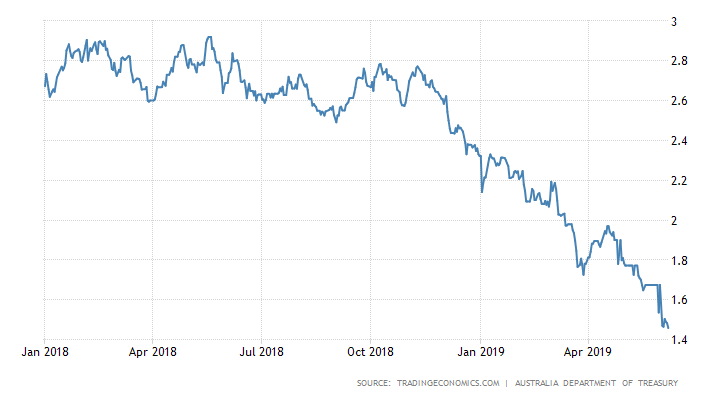For the may market, Australian shares received a strong leg up following the unexpected Coalition win in the May election. The jump in bank stocks when markets opened on the Monday, as well as continued strong commodities prices helped the S&P ASX200 index gain during the month, versus a 4.49% decline in global shares.
The increasing prospect of a new Cold War, fought in the ‘intellectual property’ arena weighed heavily on global shares. Apple was down 12.75%, and Caterpillar was down 14.06%. Contrast that to Australia, where Commonwealth Bank was up 5.35% and Telstra was up 7.98%.
| INDEX RETURNS AS AT 30 April 2019 (%) | ||||
| 1 month | 3 months | 6 months | One year | |
| Australian Shares | 1.71 | 4.88 | 15.32 | 11.08 |
| International Shares | -4.49 | 1.23 | 7.03 | 8.30 |
| Domestic Listed Property | 2.47 | 6.06 | 16.52 | 17.00 |
| Global Listed Property | -0.26 | 2.39 | 6.17 | 8.97 |
| Australian Fixed Interest | 1.70 | 3.85 | 7.08 | 8.96 |
| International Fixed Int | 1.38 | 3.14 | 5.70 | 6.04 |
| Cash | 0.15 | 0.48 | 0.99 | 1.99 |
| Market Indices | ||||
| S&P/ASX 200 Accumulation Index | ||||
| MSCI World ex Aust TR Index $A | ||||
| S&P/ASX 300 Property Trusts Accum Index | ||||
| FTSE EPRA/NAREIT DEVELOP NR INDEX (A$ HEDGED) | ||||
| Bloomberg Composite 0 + Years | ||||
| BarCap Global Aggregate Index Hedged AUD | ||||
| Bloomberg Aus Bank Bill Index | ||||
One of the driving forces in this whole rally since the lows in late December 2018 has been the easing of any threat of interest rate rises. The pivot to lower rates accelerated in May, as can be seen in the chart below of ten year bond yields in Australia. The yield to maturity has fallen from a band ranging from 2.6% to 2.9% during most of 2018, to be 1.50% at the end of May. That is right in line with the RBA Official Cash Rate as at that date.
The impact of this cannot be underestimated, and leads most commentators to the conclusion that June is a certainty for a rate cut from 1.50% to 1.25%.
Chart 1. Australian ten year government bond yield.
These lower ‘risk free’ rates of return force investors to rethink their assessment of the current value of future income streams. Or in more plain English, the price people are willing to pay for shares goes up as the price (cost) of money comes down.
Of course, the reason for lower interest rates should also be a factor in the thinking of a rational investor. Rates are lower on account of a number of factors, including trade war risks, inflation that is stubbornly below central bank targets, indications of slowing global growth, high under-employment rates.
Those risks should in the months ahead feed into wider dispersion in individual stock returns. Sectors that are defensive, such as infrastructure and utilities ought to do well if we get widespread belief that rates will be lower for that much longer. That Telstra has been doing so well lately speaks to the fact that essential infrastructure has a high value in a low interest rate world.
One thing we need to watch closely as a barometer of economic conditions is the spread between the most secure government debt and the lowest investment grade, BBB rated debt. Up till the end of April, US markets had been cheering the falling interest rates with rising stock prices. This coincided with the yield difference between US Treasuries (government bonds) and the BBB rated universe of corporate bonds (the credit spread) narrowing from 2.06% on January 3, to 1.48% on April 28. During the month of May, credit spreads widened from 1.48% to 1.71% indicating fears that conditions are deteriorating for corporate bonds. Sooner or later we will see if the risks to the economy are being read correctly by either the bond market or the stock market. Stay tuned!
If you want to get more involved with your superannuation, investments or insurance, please give us a call at Quill Group.














